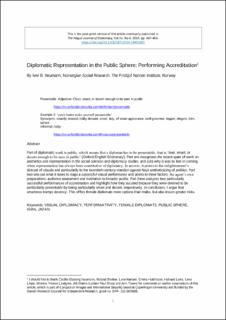| dc.contributor.author | Neumann, Iver | |
| dc.date.accessioned | 2020-08-24T10:04:00Z | |
| dc.date.available | 2020-08-24T10:04:00Z | |
| dc.date.created | 2019-10-31T13:48:45Z | |
| dc.date.issued | 2019 | |
| dc.identifier.citation | The Hague Journal of Diplomacy. 2019, 14 (4), 447-466. | en_US |
| dc.identifier.issn | 1871-1901 | |
| dc.identifier.uri | https://hdl.handle.net/11250/2673576 | |
| dc.description.abstract | Part of diplomatic work is public, so a diplomat must be presentable — that is, clean, smart or decent enough to be seen in public. This article starts by recognising the recent spate of work on aesthetics and representation in social sciences and diplomacy studies, and questions why it occurred so late when representation has always been constitutive of diplomacy, perhaps because of Enlightenment distrust of visuals and reaction against Nazi aestheticising of politics. Part two sets out what it takes to stage a successful visual performance and points to three factors: the agent’s own preparations; audience assessment; and mediatisation to a broader public. Part three analyses two successful performances of accreditation, highlighting how they succeeded because they were deemed particularly presentable by being remarkably smart and decent, respectively. In conclusion, I argue that smartness trumps decency. This offers female diplomats more options than males, but also incurs greater risks. | |
| dc.language.iso | eng | en_US |
| dc.title | Diplomatic Representation in the Public Sphere: Performing Accreditation | en_US |
| dc.type | Peer reviewed | en_US |
| dc.type | Journal article | en_US |
| dc.description.version | acceptedVersion | |
| dc.source.pagenumber | 447-466 | en_US |
| dc.source.volume | 14 | en_US |
| dc.source.journal | The Hague Journal of Diplomacy | en_US |
| dc.source.issue | 4 | en_US |
| dc.identifier.doi | 10.1163/1871191X-14401065 | |
| dc.identifier.cristin | 1742874 | |
| cristin.ispublished | true | |
| cristin.fulltext | postprint | |
| cristin.qualitycode | 1 | |
